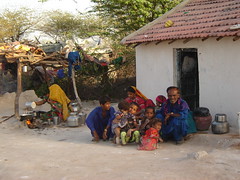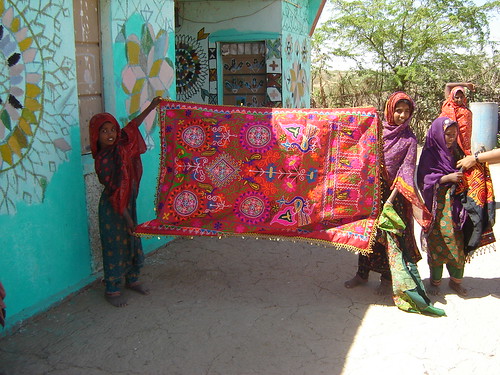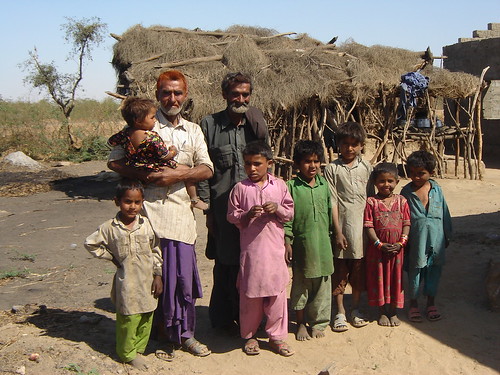By Yoginder Sikand,
Kutch, in northern Gujarat, is the second largest district in India, with an area of over 45,000 square kilometers. The district has 966 villages, and, in addition, several small settlements (called vandhs), which are not classified in the official documents. It is bounded by the Arabian Sea in the west, the Gulf of Kutch in the south and southeast, and the Rann of Kutch, a vast desert, in the north and northeast, bordering the Thar Parkar district of Pakistan’s Sindh province. In the east and south are the districts of Rajkot, Surendranagar, Patan and Banaskantha, in Gujarat and Barmer, in Rajasthan. As per the 2001 census, the district’s population was 1,526,331, of which around a third are Muslims.

Kutch’s rural Muslim population is concentrated mainly in the northern part of the district, close to the border with Pakistan. This area is largely desert or semi-desert, consisting of flat, stony and sandy plains broken by small rocky outcrops and dotted with thorny, ankle-length bushes. Most of this land is uncultivable, including the desolate Rann of Kutch, where few people live. This area faces regular spells of drought and sometimes fierce flash floods. Being an extremely arid zone that generally receives little rainfall, it can afford only one crop a year, if at all.
Communication links in this part of Kutch are extremely limited. Most settlements are remote, separated from each other by several kilometers of sand and rocky wasteland. There are few paved roads, and those that exist are in a poor shape. Numerous hamlets are located several miles from the nearest road. There are bus services to only a few settlements here. Most other settlements can be reached only by camel or, increasingly today, by small vans, called chhakaras, that take passengers on hire, but their numbers are few, their services irregular and not everyone can afford to use them. Dust storms often wipe off the tracks in the desert that connect one settlement to another. In the monsoons, large numbers of settlements are rendered marooned as the desert becomes a vast lake. In the scorching summers, wells and ponds dry up, forcing people in many settlements that have no government-provided sources of water to buy water for themselves and their animals.
The majority of the Muslims in this part of Kutch live below the officially recognized poverty line. Almost no family in the villages where the Jeevan Talim project operates has a pakka house, their homes generally being made of twigs plastered together with mud. Most villages are without electricity, piped water and government schools. There is not a single health centre in any of these villages. Although most of the Muslim castes which live here are classified as among the Other Backward Classes (OBCs), they have not benefited in any visible way from state-funded programmes for the OBCs. Only a small number of children get scholarships from the state meant for OBCs, but the sum is paltry—between seventy-five and a hundred and fifty rupees a month. No village seems to have benefited from any government-funded development scheme. Families in several settlements where the Jeevan Talim project functions do not even own the land on which their huts stand, this land being, technically, government-owned simtad zamin or wasteland and jungle. Despite petitioning the relevant authorities for several years, in some cases for over two decades, they have not been able to receive titles to the land. Since their land is not gramtad zamin, that is land which is officially part of a settled village and is recognized in the government records, they do not benefit from any government scheme. Many complain that because of this they are also sometimes harassed by their neighbours for grazing their cattle in the common pastures and for consuming water from village wells and ponds, water being a rare commodity in the desert. Large numbers of these families are migrants from drought-hit parts of Kutch. Their names are on the voters’ lists in their original villages, which they hardly, if ever, visit. Because they cannot vote in their present places of habitation, the local elected officials, from the panchayat level upwards, ignore them, showing little concern about their problems, and doing even less, or, more commonly, nothing at all, to address them.
Landholdings in the region are small, and hardly produce enough for families to make their ends meet. Most families supplement their meagre incomes by rearing livestock, including camels, goats and buffaloes. Yet, because pasture lands are limited, and because of the prohibitive cost of fodder in the market, most families have only small herds of animals. The rapid cutting down of the relatively few trees that exist for fuel, in addition to over-grazing is now posing major problems for the environment, besides making livestock rearing a less remunerative source of income. As a result of these pressures, increasing numbers of rural Kutchi Muslim men take up seasonal employment in the rural areas of southern Kutch, in fields owned mainly by the rich Hindu Patel community, or as daily manual labourers in factories towns in Kutch and beyond, there being virtually no industries in this part of Kutch. There are almost no government employees from these Muslim communities, even in the low-paid and low-ranking services. In recent years a new source of income has appeared for many families in the area—cutting bushes to make charcoal, which is sold through middlemen who regularly visit the villages.

As in the Hindu case, the Muslims of Kutch are divided into a number of endogamous caste-like groups, also known as zaat or biraderi. Unlike in the Hindu case, however, they are not ranked in a hierarchical order, and are considered to be roughly of the same social status. Besides, they are also roughly equal in terms of economic status as well, being, for the most part, at or below the officially declared poverty line. The richer and more educated Muslim castes in Kutch, such as the Memons, Bohras and Khojahs, live mainly in the towns, and have little or nothing to do with the Muslim communities living in the rural areas. Nor have they taken any active interest in doing anything for the development of these communities.
There are estimated to be almost eighty different Muslim largely endogamous castes in Kutch. Of these, the principal communities in the area where the Jeevan Talim project operates are Baluchis, Bhattis, Changal Girasias, Faqirs, Halepotras, Hajjams, Hingorjas, Jaths, Jiyejas, Junejas, Korars, Kumbhars, Langas, Lunais, Miyanas, Mughals, Muthuas, Narejas, Nodeys, Notiyas, Raimas, Raisis, Samejas, Sammas, Sarkis, Shaikhs, Siddis, Sodhas, Sumras, Suna Girasias, Syeds, Thakurais, Thebas and Thudiyas. The mother-tongue of most of these castes is Kutchi, a language quite distinct from Gujarati, the official language of Gujarat, and closer to Sindhi. There are also sub-dialects of Kutchi that are spoken in different parts of the district, and in some places different Muslim castes have their own particular ways of speaking Kutchi, distinct from the others. Some Muslim groups in this area claim Sindhi as their mother tongue. The medium of instruction in government schools in Kutch is Gujarati, and this poses major problems for children in the villages where the project operates who are denied the Constitutional right to receive primary education in their mother tongue.
Literacy levels among the Muslims of rural Kutch are among the lowest in the whole of India. It is estimated to be less than twenty per cent, and that of rural Muslim Kutchi women, less than three per cent. Numerous small settlements in those parts of Kutch where the Jeevan Talim project functions are located in the interiors of the desert and have no government schools. Other Muslim settlements, usually inhabited by families who have escaped from drought conditions and have taken up residence near villages located in less inhospitable terrain, are not recognized by the government and the settlers, despite their inhabitants having been living there for decades. Since these people do not have title deeds to the lands on which their modest huts stand, they are not considered to be legible to receive any assistance from the state, including in the form of government schools. Even in the few villages in the area where there are government schools, classes are generally not held at all regularly. Drop-out rates are extremely high. One reason for this is because children, once they attain the age of ten or so, are needed to help their parents graze their animals, fetch water and cut firewood. Further, in most cases these children are first-generation learners. Since their communities do not have a culture of literacy, parents often do not pay much attention to their children’s education.

Almost all the teachers appointed in the government schools in this region are from outside Kutch. Almost none of them lives in the villages where they have been appointed to teach, most having taken up a room to stay in the closest town, which may be several dozens of kilometers away. This is because most of the villages lack almost all basic amenities associated with urban life, including even electricity. Many teachers, village folk complain, spend most of the time in their homes outside Kutch, and on those few days that they come to the village ostensibly to teach they might be present for hardly two or three hours, sign their names in the school register and then hurry back to their rented accommodation in the nearest town. The fact that there may just one bus or chhakara a day linking the town and the village where they are posted, leaving for the village late in the day and returning in the early afternoon, forces them to spend just a few hours in the school. And in the fierce heat of summer and in the monsoon season, when much of this part of Kutch is often flooded, few teachers can muster up the enthusiasm to commute long distances to come to their schools to teach. Consequently, the levels of teacher and student attendance in almost all these villages is pathetically low.
This problem is further compounded by the fact that the medium of instruction in the government schools here, as elsewhere in Gujarat, is Gujarati, which, for many rural Kutchi Muslims, has little in common with their own language. Further, the textbooks used in the schools have little or no resonance with their own environment, history, culture and traditions, and are thus often seen as alien and alienating.
Even in those schools that do function, in some sense, standards are generally pathetic. Often, students are passed by their teachers simply in order that the teachers themselves are spared the blame for low standards of teaching. It is common even for students who have officially passed the sixth or seventh grade by their teachers not to know how to read and write anything other than just their names. Such children are officially recorded as ‘literate’, although, obviously, for all practical purposes they are not so.
In contrast to other parts of Gujarat, however, Kutch has traditionally remained free of Hindu-Muslim violence, even at the time of the Partition of India. But, in recent years, due to the rise of Hindutva forces in Kutch, things have begun to change. In the last two decades a few cases of riots and anti-Muslim violence have been reported from the area, although certainly not on the scale as elsewhere in Gujarat. Unlike in many other parts of Gujarat, relations between Kutchi Hindus and Muslims are, in general, more relaxed and less conflict-ridden. This is further cemented by a strong sense of a historical Kutchi identity transcending religion, although this is increasingly coming under strain today.
